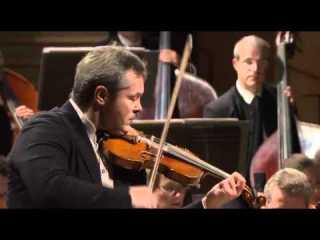Dmitri Shostakovich - First Violin Concerto (Repin) [2010]
Dmitri Shostakovich - First Violin Concerto (Repin) [2010]

I. Nocturne: Moderato II. Scherzo: Allegro III. Passacaglia: Andante - Cadenza (attacca) IV. Burlesque: Allegro con brio – Presto Vadim Repin, violin Orchestre de Paris Paavo Järvi, conductor Live internet transmission from Paris. Made public on October 13, 2010, by Arte TV.
Shostakovich had completed the first violin concerto as his Op. 77 in 1947 but felt that the political atmosphere would not tolerate it. He put it away and brought it back in 1955 as Op. 99, when it finally got published. Even then, the Soviet regime (and its attendant resources) were less than thrilled. Essentially, they did their best to ignore the work. Oistrakh's enthusiasm for the concerto, however, kept it alive.
In four movements, the concerto begins with a "Nocturne," a brooding discourse on two major themes. If night really inspired the composer, it may have been one of those bitterly cold, eerily clear Russian nights. The movement proceeds as a modified sonata, at least on paper, but dramatically something else goes on. The two themes gradually interpenetrate and wind up as something new and more intense than either separately. One also finds a curious little melodic turn that a few years later the composer will tie to his iconic D-S-C-H (D – Eb – C – B) musical signature, notably in the first cello concerto. Indeed, I hear DSCH starting in the second-movement scherzo, but it comes across as momentary rather than as something of great rhetorical import. The riff of the first movement delivers the main matter here, and the movement spits like a drop of water on a hot grill. Neither of these movements are by any measure routine. The third movement, however – a passacaglia, a contrapuntal display over a repeating bass line – lifts the concerto even higher. In fact, it may count as one of the finest symphonic discourses in Shostakovich's output.
The composer, from early on, had a fascination with older forms, like passacaglia and fugue. In many ways, he puts on a virtuoso compositional display. The bass line is not only unusually long, it's an odd seventeen bars. He gradually moves the bass line away from the lower instruments, and the theme makes its way through various registers of the orchestra with increasing power, climaxing in an overwhelming statement on the solo violin. From there, it's as if things have shattered. The violin increasingly confines itself in and around a single note – an enervated echo, perhaps, of the "one-note" theme of the second movement of Beethoven's Seventh. However, he makes you almost forget the formal aspects in favor of hard talk. Different listeners, of course, get different things from this music. For me, it's a lament – Lear on the plain, railing against a horrible reality, not mad, but clear-eyed and aghast at the desolation. Shostakovich has dug himself a deep hole. How can he possibly follow this? Yet, he does indeed move to a finale, using the Beethoven-Brahms strategy of transition and quasi-recitative. This takes the form of a long violin cadenza, which allows the listener to decompress. The solo instrument, exhausted by the passacaglia, begins with the "one note," the psychological ebb of the concerto, and from there gathers steam. Wisps of previous movements are recalled, including the riff and even a very close relative of DSCH. The rhythm becomes more and more insistent, until finally a rondo finale erupts with a boom from the kettledrum. It sounds like an update of the finale to the Tchaikovsky concerto, with the same general dance rhythm but with Shostakovich's acid harmonies and far more brutal outlook as well. Instead of Tchaikovsky's peasant joy, we get pure manic. Toward the end, the beginning of the passacaglia bass sounds almost subliminally on the French horns. The violin seems to notice this and throws it into the glare of a frantic coda. --- Steve Schwartz, classical.net
download: uploaded yandex 4shared mediafire solidfiles mega zalivalka filecloudio anonfiles oboom
Last Updated (Wednesday, 07 May 2014 09:09)








